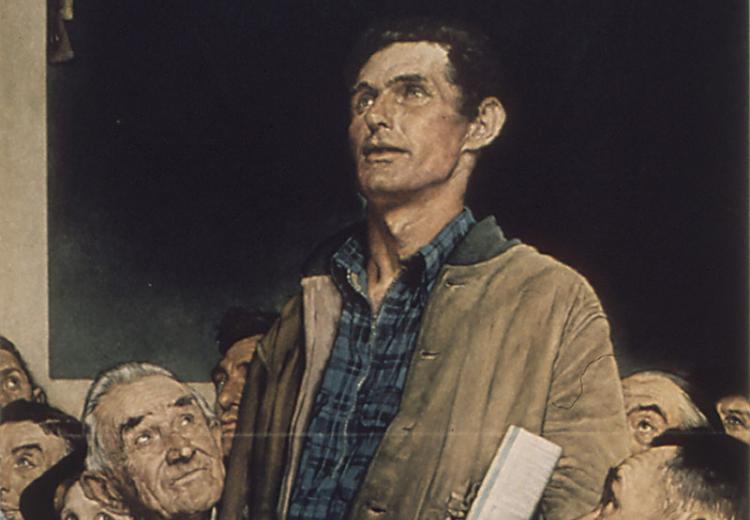

Norman Rockwell (1894–1978), "Freedom of Speech", The Saturday Evening Post, February 20, 1943.
"Congress shall make no law respecting an establishment of religion, or prohibiting the free exercise thereof; or abridging the freedom of speech, or of the press; or the right of the people peaceably to assemble, and to petition the Government for a redress of grievances.”
—The Constitution of the United States, Amendment I
Do you recognize freedom of speech when you see or hear it? As the United States apprehensively approached World War II, President Franklin Roosevelt listed four American freedoms in his State of the Union address to Congress in 1941. In order to make these abstract ideas more widely understood and appreciated, Norman Rockwell illustrated how these freedoms appear in everyday American life. In this lesson, students learn to recognize freedom of speech within their community, state, country, and world. After examining Rockwell’s Freedom of Speech, they will report on a town meeting and create a collage featuring examples of free speech.
How does Norman Rockwell’s painting Freedom of Speech illustrate the American right of free speech?
How is the First Amendment evident in everyday local community life?
Explain how artist Norman Rockwell composed this painting to idealize the right of ordinary American citizens to speak their ideas without fear of censure
Identify the five freedoms in the First Amendment (religion, assembly, press, petition, and speech) and be able to give an example of each in daily/community life, state community, national community, and international community
Subjects & Topic:When President Franklin D. Roosevelt alerted Congress to the necessity of an impending war in January 1941, he identified four ideas—freedom of speech, freedom of worship, freedom from want, and freedom from fear—which were central to the New Deal and which were also to guide his wartime policies. Yet despite an effort on the part of the government to communicate these ideas, by the summer of 1942 a survey revealed that a majority of Americans had little knowledge of the Four Freedoms. This situation inspired American illustrator Norman Rockwell to create one of his greatest artistic achievements. He conceived Four Freedoms as four idealized scenes of these freedoms in ordinary American life. These first appeared in 1943 as covers for the popular The Saturday Evening Post magazine before touring the country in an exhibit promoting the purchase of War bonds.
In the 1940’s, most Americans were familiar with Rockwell as an artist of idealized life in small-town America. His detailed scenes featuring ordinary people captured the essence of America’s generous democratic spirit. Rockwell was born in New York in 1894 and became an illustrator for Boys' Life magazine soon after graduating from art school. In 1916 he created his first of over 300 covers for The Saturday Evening Post.
During Rockwell’s career, abstract art dominated the art world. Although his art was loved by Americans, it was shunned by art museums, curators, and art historians as mere illustration, not fine art. Not until 20 years after his 1978 death did major art museums and art critics begin to acknowledge his paintings as fine art.
PreparationBefore discussing Rockwell’s Freedom of Speech, have students study it individually and write their answers on Worksheet 1: Look and Think. Use the worksheet questions and the students’ answers as a framework for a class discussion about the art. Encourage them to notice details that Rockwell added to help us understand this story and the feeling between the people in the painting.
Students will learn what the five freedoms of the First Amendment are: Freedom of Religion, Freedom of Assembly, Freedom of Press, Freedom of Petition, and Freedom of Speech. Teach students the acronym RAPPS (Religion, Assembly, Press, Petition, and Speech) to help them remember. Define the right that corresponds with each part of this acronym.
Tell the students that they will be looking through their local newspaper to find the First Amendment in action. This activity can be done individually or in pairs. Worksheet 2 is provided for this activity.
Directions:
NOTE: Do not use articles that refer to international stories or in other countries—our laws and rights are not extended into the international community.
Once students have finished, have them share their articles with the rest of the class. The presenting students should summarize their article for the class and then the class can guess which part of the First Amendment is being described.
Students will have an opportunity to place themselves in the painting, while creatively responding to writing prompts as a news reporter. Depending on the time availability, teachers may want to discuss in more depth the characteristics of various news articles (news, features, style, etc.) and allow the students to choose their type of article to write. (Worksheet 3 is provided for this activity.)
Directions:
Pretend you are a reporter covering the meeting shown in the painting. Write an article or a blog entry about this town meeting and what was said. Imagine what the other participants in the meeting said.
Answer the questions below to help frame your news article:
If interested, create a podcast of your article or create an interview using the same information as if you were the people in the painting.
AssessmentCreate a collage of First Amendment freedoms in the:
Assign students or pairs of students to each of the regions above. Have students search newspapers, magazines, campaign flyers, posters, and Internet sites to find examples of citizens exercising their First Amendment rights of free speech and assembly. Students may print out, copy, and cut out headlines, photographs, cartoons, and phrases. After arranging these to show their meaning, they may paste these on paper or cardboard. They may add marker lines to emphasize meaning. On a separate sheet of paper, have students write what they have included in their collage and why. Students should specifically point out First Amendment examples. Have students explain their collages to each other. Display the collages and their analysis.
Lesson Extensions